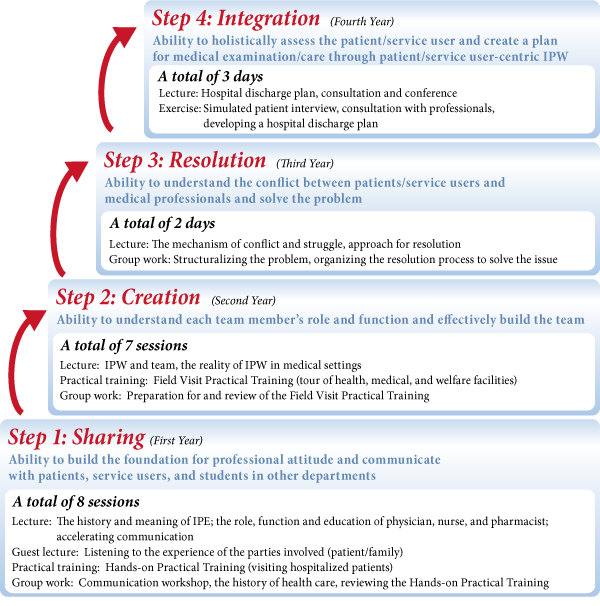Inohana IPE is a phased, comprehensive education program consisting of four steps, Step 1 (freshman) through Step 4 (senior). Each step has learning objectives.
Required Four-Year Program
Inohana IPE, which is a required courseor all three undergraduate schools, is a phased learning program with continuity overfour years. It is set as a requirement rather than elective because we believe IPW skills are essential in medical care in the future and something that we should make sure to teach as a duty of educational institution.
The Theme of Step1 is “Sharing.”
Step 1 “Sharing” is a step where students experience interactions with patients and service users, communication, workshops, and numerous group works in order to develop the ability to build the foundation for professional attitude and communicate with patients, service users, and students in other departments.
The Theme of Step 2 is “Creation.”
Step 2 “Creation” is a step where students participate in the Field Visit Practical Training at health, medical, and welfare facilities as well as in group works in order to develop the ability to understand each team member’s role and function and effectively build the team.
The Theme of Step 3 is “Resolution.”
Step 3 “Resolution” is a step where students analyze the conflict and struggle in the team and work on resolution rather than avoiding in order to develop the ability to understand the conflict between patients/service users and medical professionals and solve the problem.
The Theme of Step 4 is “Integration.”
Step 4 “Integration” is a step where students prepare a hospital discharge plan in a team by integrating the IPE-related understanding that they have built up since Step 1 and the acquired knowledge in own specialized field in order to develop the ability to holistically assess the patient/service user and create a plan for medical examination/care through patient and service user-centric IPW.
Through the above four steps, we strive to develop autonomous healthcare professionals with sophisticated expertise and the attitude to serve for the sake of patient and service users who will work with various professionals, improve each other, and keep learning while being autonomous. (Please refer to the specific page for each step for more details.)
Learning Objectives in Each Step
| Step | Learning Objectives |
|---|---|
| Step 1 Sharing | Ability to build the foundation for professional attitude and communicate with patients/service users and students in other departments. Students will be able to do the following after completing Step 1:
|
| Step 2 Creation | Ability to understand each team member’s role and function and effectively build the team. Students will be able to do the following after completing Step 2:
|
| Step 3 Resolution | Ability to understand the conflict between patients/service users and medical professionals and solve the problem. Students will be able to do the following after completing Step 3:
|
| Step4 Integration | Ability to holistically assess the patient/service user and create a plan for medical examination/care through patient/service user-centric IPW. Students will be able to do the following after completing Step 4:
|
